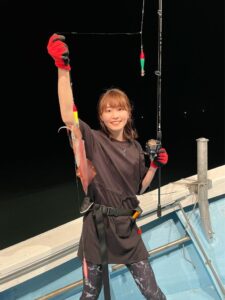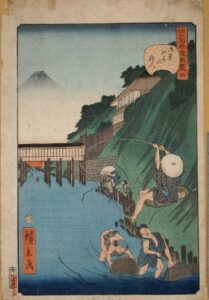Goby Fishing, the Most Popular Fish in Edo
For you, it may be hard to imagine that small and trivial fish like gobies can be a main target fish. But it has been one of the most popular and accessible fish since the Edo period.
In this article, you can see the reason why it became such a status and the way to fish it.
Species
Goby (Japanese river goby or Oriental goby, Acanthogobius flavimanus) is native to Asian countries, China, Japan, Korea, southern coast of Russia, Vietnam and Malaysia.
It grows up to 25 to 30 cm (9.8 to 11.8 inch) during its lifespan of 3 years. The body is covered by spots to be effective to hide on the bottom. The body shape is cylindrical and long. The size of the mouth compared to its body is large, suitable for its eating habit.
As a carnivore species, the Japanese river gobies are feeding on various food sources. Adult individuals, which are over 10 cm (5 inch) in length, attack on crabs, shrimps and other small fish. Smaller fish are eating ragworms.
Their favorite place to live is the sand bottom with some structures to hide. Their dwelling depth ranges from 10 m (33 ft) to the very shallow right to the shore. They can survive in freshwater as well as saltwater. In Japan, it is often seen around the river mouth, where the beach or estuaries are nearby.
History of Goby and Japanese people
Gobies must have been a very familiar fish to Japanese people, because it lives quite close to the shore and can be easily noticed.
To show it was the case in the earlier period of Japanese history, we can look at the record, called Engishiki, which collected the laws and customs around the emperor, compiled in the early 900. According to this book, the dried goby was used for cooking. However, it was compiled in the current Kyoto area and it said that this dried goby was delivered from Yamato, current Nara area. I assume dried gobies at that time were used for adding flavors in soup or as the ingredients of soup stock. In some areas in Japan, freshwater gobies, grilled then dried, are sold. Currently dried goby is often soaked in Sake, or rice wine, to add special flavor.
Though this species does not grow large, it was not the main food for these high ranked people.
But this status of goby changed when the capital was moved to Edo, current Tokyo area. This new capital was made by the Shogun Tokugawa, in 1603, when the Edo period started. During this period, there were no civil wars in Japan and it kept people’s lives in Edo very peaceful.
In the Edo area, currently Tokyo downtown and waterfront area, there were a lot of estuaries. The Tokyo bay was surrounded by the sand or muddy bottom, on which various kinds of creatures were living. Of course, one of the animals was goby.
This situation brought many people to leisure fishing. And goby became one of the most popular target fish then.
As you know, for Japanese people, there must be a condition for one fish species to be a popular fishing target. Yes. It should taste good.
In the earlier times, the way of eating was to dry and only used as a kind of soup stock. There must have been no good way of cooking or seasoning for it. As you can imagine, it is not easy to eat only its fish meat. Even with the thin tipped Japanese chopsticks, it is irresistible to take the meat away from its bone.
It is tempura which brought gobies into the stardom of fishing in the Edo period. Tempura is a Japanese cuisine, to deep-fry the ingredients with butter. Until the beginning of this period, the production of oil was limited and to fry in the full of oil was not an accessible method of cooking. Supported by the Shogunate’s governance to increase the production of food sources to sustain the big city, the rapeseed oil production increased and there came a lot of restaurants which started to serve Tempura in that period of time. Tempura was seen in the record firstly in 1748 (you can check this book in this archive.)
With this deep fry, you can cook the whole fish and you can eat all the fish as it is.
And the next reason for this fish to become a popular star was that it was easy to catch. The late summer and autumn are the seasons when gobies are eating a lot to be ready for the winter. From its aggressive predatory nature, during that period, it reacts to the moving object easily. It makes fishing easy, in conjunction with the vast population of goby in these rich estuaries. In the high season, this goby fishing was the biggest outing for the people in Edo.
After Japan’s economy grew, many of the original estuaries were reduced hugely. But there are still many gobies, though it is not as many as there were in the Edo period, to entertain fishermans.
Fishing for goby
As the fish are coming close to the shore at a good timing, it can be fished easily with a whip rod of about 2 to 3 m (7 to 10 ft.)
What you can see in the above image is the rigs for this fishing. This is a kind of balancer rig with a very light sinker. Often, this style of rigs is used for white smelting as well as for goby.
As the rod was made of bamboo, the sinker is about 10 to 15 g, I assume.
The current application of the same method is like this.
The modern trend is more direct and lighter, with the option of float fishing. Some of the examples of rigs are below.
These rigs are used, connecting to a telescopic whip rod.
While the rig style has changed during the last few hundred years, the technique has been the same. The hooked ragworms and this rig is thrown away, then you drag or bump the bottom. As fish are starving, what you need is to hook the fish at proper timing.
It is nice that we can enjoy the same target fish as people of the Edo period did. Though the surroundings had changed, the culture and the enjoyment has been there among anglers.

